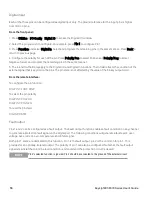
The power supply’s OVP circuit will program the output to zero whenever the overvoltage condition occurs. If
external voltage source such as battery is connected across the output, and the overvoltage condition inad-
vertently occurs, the current from the voltage source will sink through the internal circuitry; possibly damaging
the power supply. To avoid this, a diode must be connected in series with the output as shown below.
OCP State
With over-current protection enabled, the power supply disables the output if the output current reaches the
current limit setting, which causes a transition from CV to CC mode.
Press
OCP State On
to enable over-current protection.
Press
OCP State Off
to disable over-current protection.
You can also specify a delay to prevent momentary CV-to-CC status changes from tripping the OCP. The delay
can be programmed from 0 to 3600 seconds. You can specify if the start of the delay is initiated by any trans-
ition into CC mode, or only at the end of a settings change in voltage, current or output state.
OCP Delay
The power supply may momentarily cross into CC mode when it is turned on, when an output value is programmed,
or when the output load is connected. In most cases these temporary conditions would not be considered an over-
current protection fault, and having an OCP condition disables the output when the CC status bit is set would be a
nuisance. Specifying an OCP delay will ignore the CC status bit during the specified delay period.
To set the over-current protection delay, enter the delay value in the OC Protection Delay field. The delay can be
programmed from 0 to 3600 seconds.
OCP Delay Start
Specifying an OCP Delay Start lets the OCP circuit ignore the CC status bit during the specified delay period. Once
the OCP delay time has expired and if the CC mode persists, the output will shut down.
You can specify the OCP delay start timer through:
– CC Transition: delay timer start at any transition of the output into CC mode. Press
OCP Start CC
.
60
Keysight E36300 Series User's Guide
















































